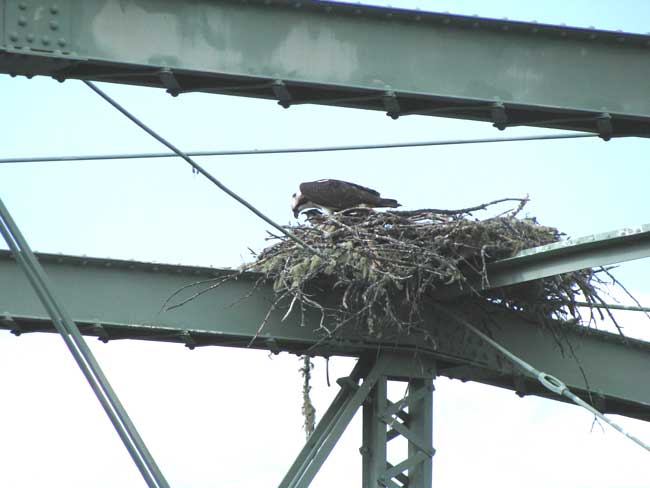Excerpts from Jim Conrad's
Naturalist Newsletter

from the the July 12, 2009 Newsletter, issued from the Siskiyou Mountains west of Grants Pass, Oregon:
OSPREY NEST
A few years ago they constructed a new bridge over the Rogue River on the way to Merlin. Instead of tearing down the old bridge they left it there, barricading it and building the new bridge beside it. Soon a pair of Ospreys, PANDION HALIAETUS, built a big, messy-looking nest atop the old bridge's upper girders, clearly visible from the new bridge. For years Osprey families have continued raising young there, usually two young per season. You can see the nest above. A close-up of an adult feeding a nestling is below:

The Ospreys and their nest have become a local attraction, everyone for miles around keeping tabs on what goes on day to day. In the spring often you see an adult patrolling the pretty Rogue below, frequently carrying a fish, for an Osprey's diet is 99% fish. Even in a moving car you can see the nestlings' heads above the nest and sometimes you see feeding, nest- edge perching, and other activities.
The word Osprey looks like it might derive from good old Germanic roots but it's a corruption of the ancient Latin avis praedæ, meaning simply "bird of prey." This reflects the fact that Ospreys also occur in Eurasia; in fact, they have a worldwide distribution and are found on all continents except Antarctica. European Ospreys overwinter in Africa while American and Canadian birds fly to Latin America, although some overwinter in the US Deep South.
Ospreys usually mate for life, though rare instances of polyandry -- the female taking more than one mate -- have been recorded.
from the September 7, 2007 Newsletter, issued from Sierra Gorda Biosphere Reserve, QUERÉTARO, MÉXICO:
OSPREY BRINGS AN AUTUMN FEELING
Until a couple of weeks ago our rainy season had been a piddling one. Hurricane Dean changed that, ushering in day after day of drizzle and showers. Last Friday while walking along the reservoir in the rain I saw an Osprey sailing in and out of white showers drawing across the lake.
Ospreys occur here only while migrating and in the winter, so this bird reminded me that somehow already the summer rainy season is mostly over, and that now days are shortening as the winter dry season approaches.
When I was a kid in Kentucky Ospreys appeared only as they migrated between their wintering grounds much farther to the south and their nesting grounds much farther to the north so, to me, Ospreys are "change birds." Last Friday when I saw that Osprey I was like Pavlov's dog reacting to a ringing bell: The Osprey automatically induced in me a sense of change. Also, I wondered where he'd just come from, what swamps, and towns and busy interstate highways he'd just sailed over.
In Mexico Ospreys live year-round along the northwestern coast and the Yucatan's eastern coast. Northern birds winter all along the coasts of both sides of the country, and here and there in the uplands, including at Jalpan's reservoir.
Last Friday, as the Osprey reconnoitered the reservoir's misty shoreline, a Wilson's Warbler -- also a winter visitor here -- flitted and chipped in the Sweet Acacia behind me, shaking silvery water droplets from deep-green acacia leaflets. When I walked away several Spotted Sandpipers flushed from a nearby bank and of course they also were winter visitors.